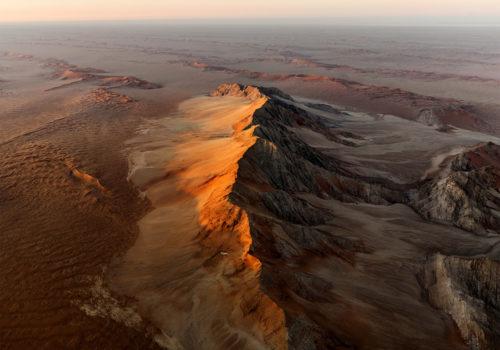The Berlin gallery presents a selection from series by the Canadian photographer produced on the African continent. Aerial views of breathtaking pictorial power which bear witness to the effects of industrial expansion on African landscapes while celebrating those still preserved from human exploitation.
How can we measure the impact of human activity on our planet, other than through data? How can we represent the damage caused by industrial activity, other than through images of devastation? How can we talk about Africa today other than through poverty?
For seven years, from 2015 to 2020, Edward Burtynsky explored ten African countries from the air – the aerial point of view being, according to him, the most powerful scale to reveal the immensity of his subject.
“Viewing the landscape from elevated perspectives reveals the design, structure and scale of the marks we make on the Earth’s surface, extraordinary vistas not visible at ground level.” he confides.
Suspended from a helicopter, a small plane or with the help of a drone, he explores natural sites exploited by humans and others still intact. A quest that leads him to capture natural phenomena in Tanzania, Namibia and Botswana. Against this stunning wilderness, the photographer presents birds-eye views of agricultural, industrial and urban landscapes. Here, at the Springer gallery, we are confronted with our own contradictory emotions, admiring the exploitation of sulfur in the Danakil desert in Ethiopia, that of salt in Senegal or even those of iron and diamonds in South Africa.
The beauty of a fragile world
The combinations of tones, reliefs and curves give these natural and artificial landscapes the incredible appearance of works of art. The shades of green of the salt marshes near Tikat Benguel in Senegal (2019) and the choreography of their rectangular shapes instantly echo Gustav Klimt’s The Kiss; the strata of the Tsaus mountains in Namibia (2018) recall the leaf cutouts of Henri Matisse; or again, the iron ore mines captured in Kathu in South Africa (2018) respond to the iconic abstract line of Jackson Pollock.
“I am drawn to and excited by the act of creating large, highly detailed and expressive images, while trying to remain conscious of keeping two doors open through which the viewer can enter the work: form and content.”
Behind the wonder aroused by these different phenomena, these photographs from above all document a continent on the eve of the point of no return.
China yesterday, Africa today
During the 2000s, Edward Burtynsky followed the development of factories in China and the unequivocal degradation of the environment caused by this rapid industrial expansion. Places that look like anthills with the smell of human exploitation and ecological disaster – images in which it is also fascinating to immerse yourself again.
The artist confides that even then, he had a feeling that Africa would be the next great factory on our planet. Because living with 8 billion people on Earth in the era of globalization requires an infinite number of resources. And if many countries had already been overexploited, some African countries were only at the dawn of it.
Two decades later, China took over Africa, taking advantage of low labor costs, lax environmental regulations and almost non-existent economic taxes. The African continent crystallizes the Chinese giant’s unique chance to shed its hat as the world’s factory to realize its aspiration to become a major service country. In the monograph African Studies edited by Steidl, this semantic shift is striking: the photographs of yesterday’s Chinese workers resonate frighteningly with the clichés of Asian factories now located in Senegal or Ethiopia.
A plea for nature
In times of climate crisis, Burtynsky’s visual language approaches the subject differently. Far from scenes of devastation, the Canadian photographer devotes the powerful aesthetic of his works to the celebration of our environment. But where these scenes stimulate our minds, they must also question.
This composition formed of the warm colors of the earth and the traces left by trucks on the sand in this image of gold mining in South Africa questions more broadly the dramatic effects of the exploitation of precious resources for the satisfaction of outrageous lifestyles in our capitalist societies.
Behind the incredible dance of colors of the salt marshes near Fatick in Senegal – the largest salt producer in Africa, lies a great ecological drama for the region because over-salinity leads to an acceleration of climate change of which local populations are the first victims.
For the sumptuous photograph of the Sossusvlei dunes in Namibia, Burtynsky traveled by helicopter to this off-center area in order to capture this precise moment of sunrise where its position infuses this particularly dramatic atmosphere. This protected area illustrates the fragility of what we call the new gold, excessively exploited throughout the continent, among others by the construction sector, and affecting our natural ecosystem.
Burtynsky overturns the idea that a shock would be necessary to raise awareness of the impending drama. Faced with urgency, he whispers to us: “look what we have, look what we are doing with it.”
Noémie de Bellaigue
African Studies by Edward Burtynsky at the Springer Gallery until March 2, 2024.
The Saatchi Gallery in London presents from February 14 to May 6, 2024 the largest exhibition dedicated to the work of Edward Burtynsky.
Galerie Springer
Fasanenstraße 13
10623 Berlin
https://www.galeriespringer.de
















